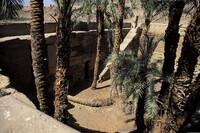| dc.coverage.spatial | Site: Dendara Temple Complex (Qina, Upper Egypt, Egypt) | en_US |
| dc.coverage.temporal | ca. 2000 BCE-200 CE (inclusive) | en_US |
| dc.creator | unknown (Egyptian (ancient)) | en_US |
| dc.date | -2000-200 | en_US |
| dc.date.accessioned | 2013-04-12T19:30:51Z | |
| dc.date.available | 2013-04-12T19:30:51Z | |
| dc.date.issued | -2000-200 | en_US |
| dc.identifier | 208609 | en_US |
| dc.identifier.other | archrefid: 969 | en_US |
| dc.identifier.uri | http://hdl.handle.net/1721.3/116483 | |
| dc.description | General view, looking down; 'Sacred lake' is a term for an artificial body of water within ancient Egyptian temple precincts from the Old Kingdom (ca. 2575-ca. 2150 BCE) to the Roman period (ca. 30 BCE-395 CE). Sacred lakes were usually fed by ground-water, differing in this from other kinds of temple waters such as stone-lined canals (connecting the temple with the Nile), and larger than the square or circular wells. The various types of sacred lakes served a number of cultic purposes: at Dendara it was 'the place of appeasement of the lion-goddess'. Source: Grove Art Online; http://www.groveart.com/ (accessed 1/19/2008) | en_US |
| dc.format.medium | stone; limestone | en_US |
| dc.rights | © Scott Gilchrist, Archivision, Inc. | en_US |
| dc.subject | animals | en_US |
| dc.subject | deities | en_US |
| dc.subject | Egypt--Religion | en_US |
| dc.subject | Ptolemaic | en_US |
| dc.title | Dendara Complex; Sacred Lake | en_US |
| dc.title.alternative | Dendera Complex; Sacred Lake | en_US |
| dc.type | image | en_US |
| dc.rights.access | Licensed for educational and research use by the MIT community only | en_US |
| dc.identifier.vendorcode | 1A3-EG-D-5-A4 | en_US |
| vra.culturalContext | Egyptian (ancient) | en_US |
| vra.technique | construction (assembling) | en_US |
| vra.worktype | excavation (site) | en_US |
| vra.worktype | pond | en_US |
| dc.contributor.display | unknown (Egyptian (ancient)) | en_US |


